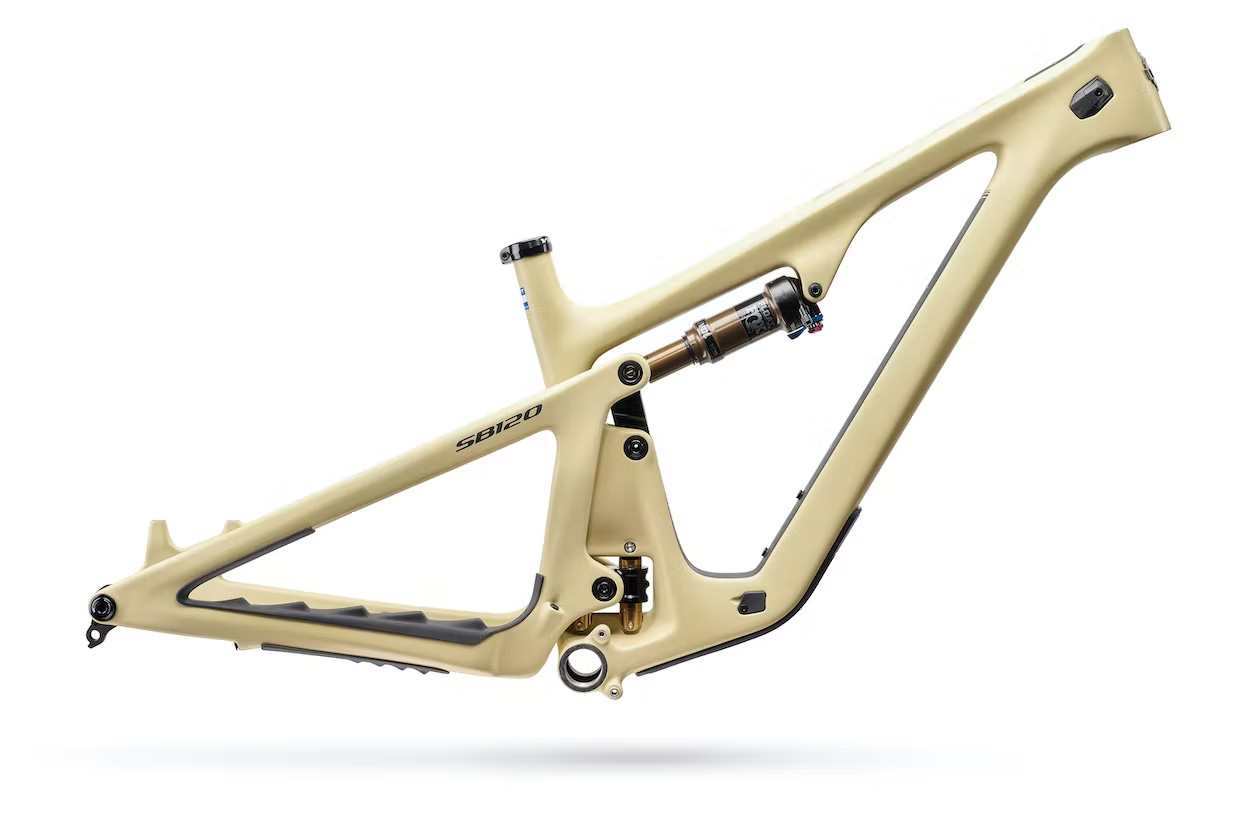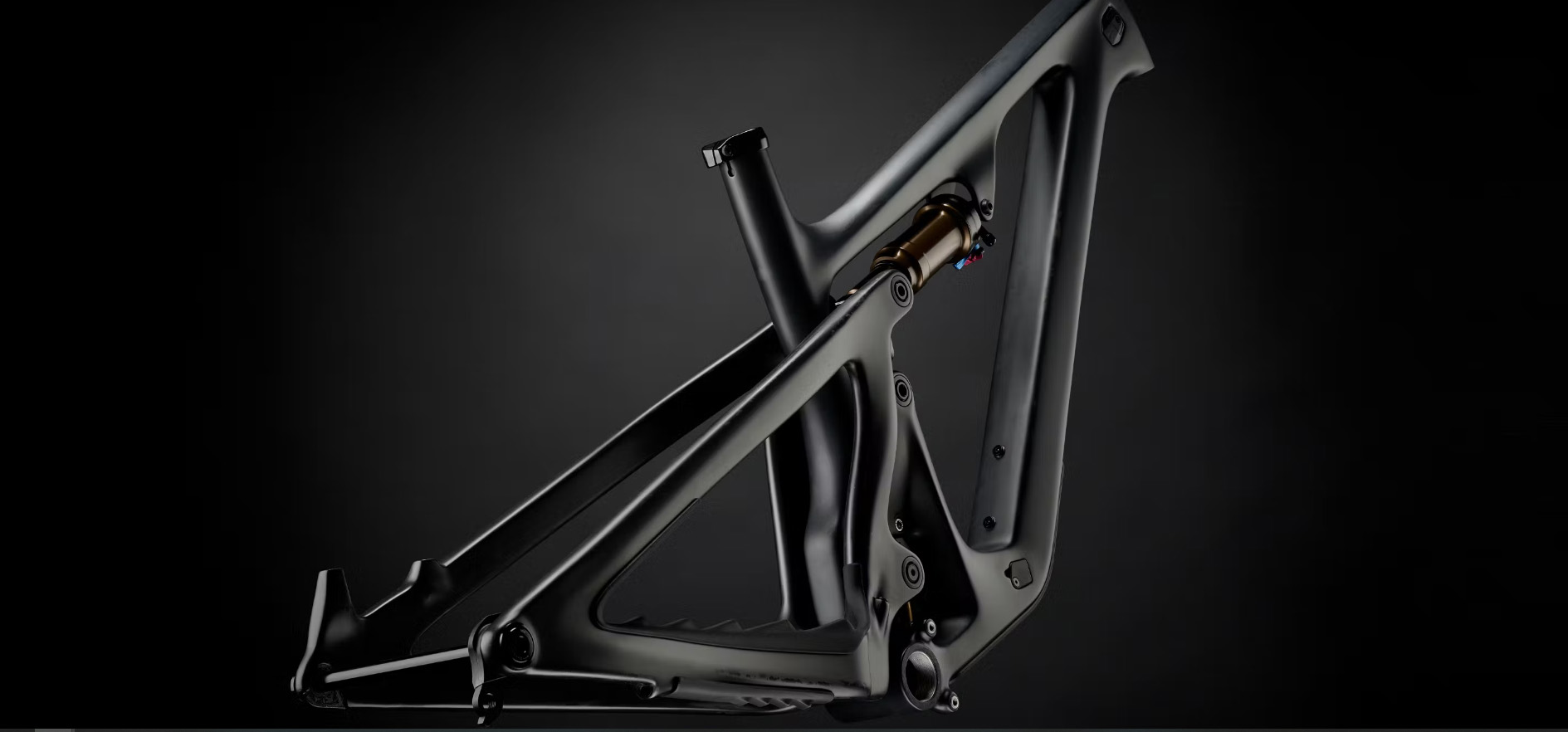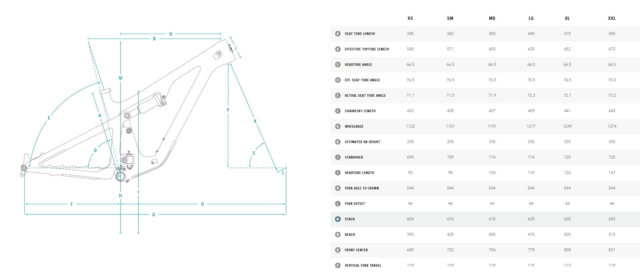Yeti SB120
Wheel Size: 29’’
Travel: 120 mm rear / 130 mm front
Geometry highlights:
- Sizes offered: XS, S, M, L, XL, XXL
- Headtube angle: 66.5°
- Seat tube angle: 76.5°
- Reach: 475 mm (size Large)
- Chainstay length: 433 mm to 443 mm (2 mm increments per size)
Frame material: Carbon Fiber
Price:
- Frame w/ Fox Float DPS
- Factory shock: $4,300
- Complete bikes: $6,300 to $12,100

Intro
Right after launching the SB160 Enduro bike, Yeti followed it up with the new SB120, which packs a whole lot of the same design elements into a much shorter-travel package. The SB120 effectively replaces the SB115, and the way that Yeti talks about is interesting. On one hand, there’s talk of “crushing souls on the descent” and “numbers that exceed travel,” seeming to imply that Yeti means the SB120 to be a fairly game-on descending bike for its class. But at the same time, the SB120’s geometry isn’t wildly aggressive, especially as bikes like the Chromag Darco and Canyon Spectral 125 have pushed the envelope for what a ~120mm-travel bike can look like. So how does that all add up? Let’s take a look.
The Frame
Yeti says that the SB120’s silhouette more closely resembles their longer-travel bikes than the SB115’s did, but the differences are still fairly subtle. The overall layout, with their Switch Infinity slider taking the place of a lower link and a horizontally-mounted shock driven by a rocker link and short yoke, will be familiar to anyone who’s paid attention to Yetis of recent years. That layout produces a nice, straight leverage curve with about 11% total progression (roughly 2.8:1 to 2.6:1). That’s quite a bit less than the SB160’s 17% progression, which generally makes sense for the shorter-travel bike, in our estimation — with less travel on tap, it seems sensible to run a firmer suspension setup, both to help with pedaling efficiency and to bolster support to keep the SB120’s limited travel available for when you really need it. (The SB120 has 120 mm of rear wheel travel and is designed for 29’’ wheels).

The SB120 gets a lot of the same updates that we just saw on the SB160. The downtube hump isn’t gone entirely, but it’s been smoothed out to improve clearance and there’s still a rubber guard on it in case you still manage to smash it on something. The increased downtube clearance hasn’t taken away space for a water bottle inside the front triangle across the size range, and the chainstay and seatstay guards have been beefed up to help keep things quiet. On that note, the cable routing is still internal, but bolt-on covers clamp the cables at the exit points to better keep them in place with the goal of preventing rattling and rubbing. The PF92 bottom bracket shell from the SB115 is gone, in favor of a threaded one (which we’re pleased to see). And as with the SB160, there’s a new SRAM UDH derailleur hanger. The forward two tabs of an ISCG-05 mount are also present if you want to run an upper guide, but a bashguard isn’t in the cards.
In addition to those refinements, Yeti has updated their pivot hardware and bearing layout so that all of the pivot bearings (standard sizes throughout) are pressed into the aluminum linkage parts, rather than the carbon fiber frame components. That both reduces the likelihood of a catastrophic mishap in replacing a bearing, and lowers the cost of fixing one, should something go wrong. We’ve also seen carbon fiber bearing seats become sloppy and develop play on some bikes that feature them, so this seems like a positive development all around. The pivot axles also use a floating design (similar to fork through-axles from Fox, Ohlins, and others) to compensate for any variations in bearing spacing due to manufacturing tolerances and assembly clearances, which Yeti says should help improve bearing life.

Fit & Geometry
Yeti offers the SB120 in six sizes, from XS through XXL, with reach numbers ranging from 395 mm to 515 mm; the Large clocks in at 475 mm. The headtube angle is a somewhat-steep 66.5° across the board, paired with a 76.5° effective seat tube angle for all sizes. The chainstay length does vary by size, with the XS starting at a not-that-short 433 mm, and each successive size gaining 2 mm, up to the 443 mm stays on the XXL.
Yeti says that those sizes will cover folks from 4’10’’ to 6’11’’ (145 to 210 cm), which is quite a range, but we’re a little skeptical about the top end of that spectrum — the steps in reach tail off toward the bigger sizes, and the XXL’s 515 mm figure isn’t all that huge, especially considering the fairly steep seat tube angle and the not-crazy-long effective top tube that results.
It’s interesting that Yeti hasn’t opted to go slacker on the headtube angle of the SB120, given how they talk about it as an aggressive-descending bike. Their prior-generation SB130 and SB150 (longer-travel bikes, granted) were notably progressive in terms of their geometry when they launched some years back, but Yeti hasn’t continued to push the envelope on that front, for better or worse.
The Builds
The SB120 is available in five complete builds that closely mirror those offered on the SB160. Aside from the cheapest (but not exactly “budget”) C1 build, all feature SRAM drivetrains and brakes, though Fox suspension is spec’d throughout. (There’s an obvious gap in the model numbering where the T2 would go, and we wouldn’t be surprised if a higher-end Shimano build popped up at some point.) In keeping with Yeti’s normal naming conventions, the “C” builds get the more basic “Carbon” series frame, with the “T” builds featuring the lighter “Turq” one.
And if you’d rather build your own SB120, the frame-only price for the SB120 is still quite expensive, at $4,300, though that’s substantially less than the $5,000 that the SB160 commands.

- Drivetrain: Shimano SLX w/ XT shifter
- Brakes: Shimano SLX 4-piston w/ 180 mm rotors
- Fork: Fox 34 Performance
- Shock: Fox Float DPS Performance
- Wheels: Crank Brothers Synthesis Enduro
- Dropper Post: OneUp (XS–S: 150 mm; M: 180 mm; L–XXL: 210 mm)
- Drivetrain: SRAM GX
- Brakes: SRAM G2 R w/ 180 mm rotors
- Fork: Fox 34 Performance
- Shock: Fox Float DPS Performance
- Wheels: Crank Brothers Synthesis Enduro
- Dropper Post: OneUp (XS–S: 150 mm; M: 180 mm; L–XXL: 210 mm)
- Drivetrain: SRAM GX w/ X01 rear derailleur
- Brakes: SRAM G2 RSC w/ 180 mm rotors
- Fork: Fox 34 Factory Grip2
- Shock: Fox Float DPS Factory
- Wheels: DT Swiss XM1700
- Dropper Post: Fox Transfer (XS–S: 150 mm; M: 175 mm; L–XXL: 200 mm)
- Drivetrain: SRAM X01 Eagle AXS w/ XX1 AXS rear derailleur
- Brakes: SRAM G2 RSC w/ 180 mm rotors
- Fork: Fox 34 Factory Grip2
- Shock: Fox Float DPS Factory
- Wheels: DT Swiss XM1700
- Dropper Post: Fox Transfer (XS–S: 150 mm; M: 175 mm; L–XXL: 200 mm)
- Drivetrain: SRAM XX1 Eagle AXS
- Brakes: SRAM Level Ultimate w/ 180 mm rotors
- Fork: Fox 34 Factory Fit4
- Shock: Fox Float DPS Factory
- Wheels: DT Swiss EXC1501 Carbon
- Dropper Post: Fox Transfer SL (XS–S: 125 mm; M–XXL: 150 mm)
All of the “C” builds offer a $600 upgrade to a Fox 34 Factory fork and Float DPS rear shock. Turq T1 and T3 builds can be upgraded to a DT Swiss EXC 1501 carbon wheelset for an additional $1,000. It’s also worth noting that the top-shelf T4 build comes with substantially more XC-oriented parts than the rest of the range, with stuff like the Fit4 version of the Fox 34 fork being substituted in place of the Grip2 version offered elsewhere; a lighter (and shorter-travel) Fox Transfer SL seatpost handling those duties; SRAM Level brakes in place of G2s; and DT’s XC-oriented EXC 1501 C wheelset in place of the more Trail (or even Enduro) oriented models featured elsewhere. All of that saves over 2 lb (nearly 1 kg) in claimed weight over the next-highest-end T3 build; the stated weight steps between each of the successive models are more like 0.5 lb per trim level.
Some Questions / Things We’re Curious About
(1) Yeti’s talking a big game about the SB120’s descending prowess, and (T4 build aside) has given it comparatively burly builds that seem in keeping with that ethos, but its geometry looks a bit more conservative than we’d typically associate with the more aggressive ~120mm-travel bikes on the market. So how will that all add up on the trail?
(2) And with such diversity in the ~120mm-travel Trail bike class these days, where will the SB120 fit in on that spectrum?
Bottom Line (For Now)
The Yeti SB120 fits an interesting niche, with somewhat burly builds (apart from the top-tier and decidedly more XC-oriented T4) but notably more compact geometry than a lot of the more aggressive ~120mm-travel bikes out there. We’re not entirely sure how that’s all going to add up on trail but are curious to find out and are hoping to be able to get on an SB120 soon.

